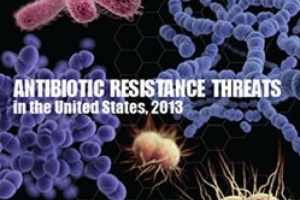Briefing speakers, report: antibiotic resistant infections “pose a catastrophic threat to people in every country”
When Rep. Gene Green (D-TX) practiced as an attorney in Texas during the 1980s, some of his clients had become infected with tuberculosis that had become resistant to the first and best line of treatment. He had to talk to them through walls to avoid exposure to the disease, he said, often having to shout to be heard. He recounted his experience at a congressional briefing on the threat of antibiotic resistance in the U.S. on Tuesday.
In his small district in the middle of Texas, TB is a big issue, Rep. Green said.
“If it’s an issue in Mexico, or any international community, it’s a problem for us,” Rep. Green said during the briefing, which was sponsored by the Centers for Disease Control and Prevention, Pew Charitable Trusts, and the Infectious Diseases Society of America, which produces this blog.
Drug-resistant tuberculosis is listed as a serious threat in the CDC’s report released Monday on antibiotic resistance and the threat it creates to fighting infectious diseases. A worldwide problem, diseases resistant to antibiotics cross international boundaries, spreading from one country to another with ease, the report says. With new antibiotic research and development at a standstill, antimicrobial resistance will continue to “pose a catastrophic threat to people in every country of the world,” the report says.
The CDC estimates that every year 2 million people in the United States become infected with bacteria that are resistant to one or more of the antibiotics designed to treat those infections. At least 23,000 people die each year in the U.S. because their infections are resistant to antibiotics.
“We talk about a pre-antibiotic era and an antibiotic era – if we’re not careful, we might see a post antibiotic era,” CDC Director Dr. Frieden warned. He likened the threat of continued antimicrobial resistance to the time he spent as a physician in New York during the height of the AIDS epidemic, in the late 1980s and early 1990s when he watched hundreds die because there were no drugs to treat them.
During the 1990s when rates of tuberculosis resurged in New York and other major cities, careful monitoring and use of drugs was essential to subduing the outbreaks, said Frieden, who ran New York’s health department at the time. Careful use — or “stewardship” of currently effective antibiotics, will be necessary to prevent resistance to those drugs. Also necessary, he said are:
- preventing infections and preventing the spread of resistance
- tracking resistant bacteria
- promoting the development of new antibiotics and developing new diagnostic tests for resistant bacteria
But fighting antimicrobial resistance isn’t possible without committed resources, IDSA President Dr. David Relman said. The CDC’s current budget is the lowest it’s been in a decade, risking a future that may resemble the days before “miracle” drugs were developed, when people died of common infections, Dr. Relman said.
Source: Science Speaks


